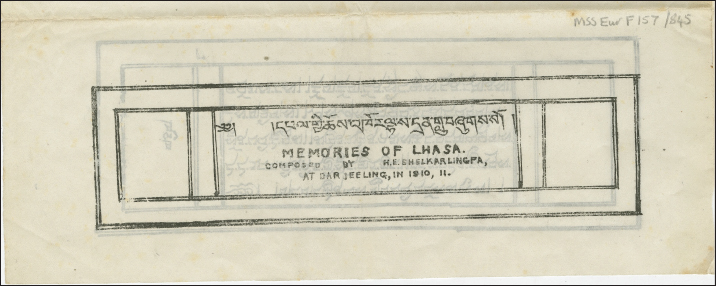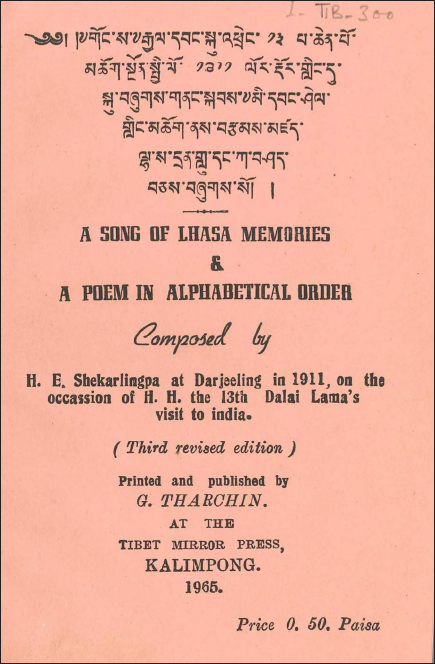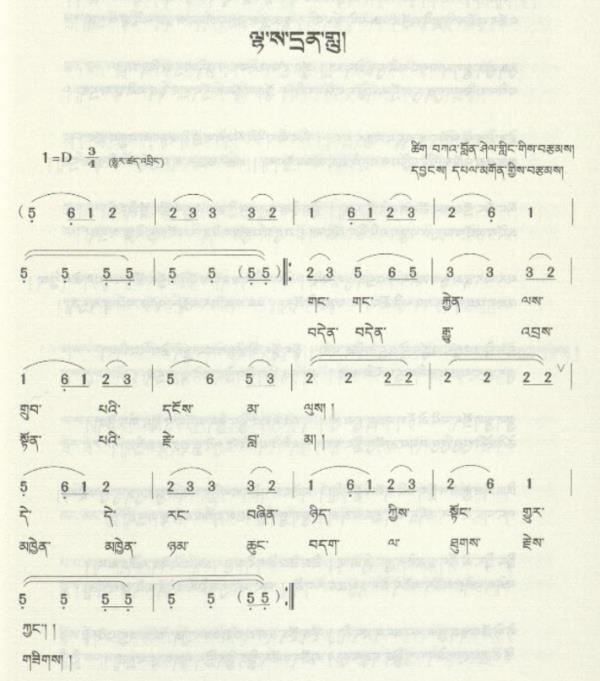Notes on Shelkar Lingpa’s “Song of Lhasa Memories”
Andrew Quintman and Kurtis R. Schaeffer
Historical Background to the “Song of Lhasa Memories”
Few compositions of the early twentieth century hold a place as dear to the hearts of Tibetan readers as the “Song of Lhasa Memories.” This ornate poem, composed by Shelkar Lingpa (Shel dkar gling pa, 1876–1913) in the Indian hill station of Darjeeling, evokes everyday life in faraway Lhasa, even as it makes not-so-subtle barbs at the Chinese military that had forced him into exile. Here, we use the English title adopted by Geshe N. L. Nornang and Lawrence Epstein in their mid-1980s translation of the poem, published in the present issue of the Journal of Tibetan Literature (Volume 2.1, 2023, 85-100). The short title “Lha sa dran glu,” by which it is most frequently known, suggests memories of, or perhaps nostalgia for, the holy city of Lhasa. But the word dran here also conveys the sense of an intense emotional response. For this reason, Lama Jabb (2019) renders the title “Song of Longing for Lhasa.” Treling Wangdor’s (Bkras gling dbang rdor) 2016 edition and translation has “Yearning for Lhasa.” T. D. Gonkatsang (n.d.) renders the full publication title (dpal gyi chos ’khor lha sa dran glu nor bu’i do shal) as “The Precious Crystal of Songs in Memories of Holy Lhasa.”
In February of 1910, the Qing Amban, General Zhong Ying, led the Chinese army into Lhasa, in part with the intention of detaining the Thirteenth Dalai Lama Ngawang Losang Thupten Gyatso (1876–1933). The Dalai Lama, in response, fled from Lhasa to the British hill station of Darjeeling in northeast India. He remained in India through the collapse of the Qing Dynasty in 1911, returning to Tibet in 1912.[1]
Among the Dalai Lama’s entourage was Shelkar Lingpa, at the time a district governor (rdzong dpon) within the Tibetan administration.[2] It was during this period of exile in the Indian Himalayan foothills that Shelkar Lingpa composed his “Song of Lhasa Memories.” Tsewang Namgyal (Tshe dbang rnam rgyal) suggests that the poem was written at the behest of the Dalai Lama, an idea repeated by Bendé Khar (Ban de mkhar) in his 2014 work discussed below.[3] Shelkar Lingpa would eventually be promoted to the positions of deputy minister (bka’ tshab) and then minister (bka’ blon), upon his return to Tibet.[4] He died shortly thereafter.
Although the initial reception of “Song of Lhasa Memories” is unclear, it was first published in print form in the early 1930s, and reprinted numerous times since then as outlined below. By the 1980s it had become sufficiently popular for excerpts from it to be included in Tibetan-language secondary school textbooks in China. As Janet Upton has shown, these excerpts strategically present the poem as an ode to Lhasa as a secular city.[5] In the midst of significant changes to the poem over the decades since its original publication, noted below, it has remained an indelible part of twentieth-century Tibetan literary history, and it continues to inspire Tibetan poets, authors, and performers. “What is remarkable about ‘A Song of Lhasa Memories,’” Lauran Hartley has noted, “is how the contemporary is made tangible in the poet’s expression of longing for Lhasa.”[6] This may be witnessed in more traditional forms of Tibetan expression, such as Palgön’s (Dpal mgon) setting of the poem to music described below,[7] the inclusion of excerpts in histories of Tibetan literature,[8] or the controversial depiction of Lhasa street life in Jamyang Norbu’s 1985 TIPA performance, which took its name, and perhaps a sort of ironic inspiration, from Shelkar Lingpa’s poem.[9]
Beyond its strictly aesthetic appeal to Tibetan readers, Shelkar Lingpa’s “Song of Lhasa Memories” has attracted the attention of both native and non-native scholars of Tibetan literature up to the present day.[10] Of special note are the essays by Tsewang Namgyal (1983) and Tenzin Dorjé (2009). The former cites and analyzes several of Shelkar Lingpa’s works, including a work of mixed verse and prose titled Rang tshul brjod pa’i ’bel gtam and an alphabet poem titled Rang tshul brjod pa’i ka bshad. He also mentions yet another work, the Yod ’don drang thig mthong ba ’dzum shor. The latter consists of recollections of Shelkar Lingpa by one of his descendants and includes reference to a memoir penned by the poet entitled Rang tshul brjod pa’i gtam dpyid kyi nyi ring phud thabs. These two will make a good starting point for those wishing to explore Shelkar Lingpa’s literary output beyond the “Song of Lhasa Memories.” Of these titles, only the alphabet poem is available to us at present, for it was reprinted in the 1965 edition of the “Song of Lhasa Memories.”
Structure and Contents
The 1936 print of the “Song of Lhasa Memories” contains forty-six verses, each with four lines of nine syllables. Nearly every line begins with a reduplicated initial consonant (gang gang, de de, bden bden, and so forth), while some lines begin with two sets of doubled consonants (dga’ dga’ skyid skyid, etc.). Two verses introduce the poem, the first an homage and request to the deity, the second the author’s statement of intention. The next thirty-eight verses each contain the refrain that gives the song its name: “I miss Lhasa” (lha sa dran). As Janet Upton notes, in these verses
the poem invokes longings for a Tibet that most…have seen only in their mind’s eye: the Tibet of traditional Lhasa. Yet through its lyrical language, the poem effectively conveys the very object whose absence is being mourned. Lhasa comes alive, the sounds and images of the daily and annual cycles of activity in this center of Tibetan life…[11]
The final six verses include an emotional epitome of the refrain (v. 41), brief references to the relocation of Avalokiteśvara from Tibet to India and the presence of Chinese troops in Lhasa (vv. 42–43), the author’s aspiration prayers for himself and humanity (vv. 44–45), and a final statement of authorial humility (v. 46).
The verses are filled with details of everyday life in Lhasa and employ techniques from the tradition of ornate poetry to bring the reader into the poem’s evocation of the city. According to Tsewang Namgyal’s 1983 essay on the work,
This work employs the phonemic ornament of reduplication. In terms of the meanings it expresses, it is rich with lived experience and detail. It is full of both deep sentiment and the very objects [of this sentiment]. It emphasizes the pleasing features [of the city] that promote increased appreciation of its deep significance, and it clearly expresses the varieties of sorrow that come from being exiled from one’s homeland. The words that express this content are quite pleasant and harmonious, with great capacity to satisfy people’s thoughts.[12]
We find this characterization of the poem reflected, for example, in verses 10 and 11:
I miss Lhasa, with its sound of whistling arrows:
When the flowers free their abundant blooms
To picnic we go and enjoy ourselves;
The music of the transverse flute and other instruments, trala, tralee. [10]
ལྷུག་ལྷུག་གྲོལ་བའི་མེ་ཏོག་བཞད་དབུས་སུ།།
དགའ་དགའ་སྐྱིད་སྐྱིད་གཏོང་དུ་གླིང་ཁར་ཕྱིན།།
ཙེའི་ཙེའི་འུའུ་འུའུ་འབའ་ཆ་ཧོར་གླིང་དང་༌།།
ཨིའི་ཨིའི་འབི་ཤུའི་སྒྲ་ལྡན་ལྷ་ས་དྲན།། [10]
I miss Lhasa: The crunching sounds of mealtimes,
The formal settings of tasty preparations of Chinese food,
Raised on high and respectfully offered before one;
And then taking up whatever one wishes to eat. [11]
ཞིམ་ཞིམ་རྒྱ་ཟས་བསྒྲིགས་པའི་གསོལ་སྒྲོན་ནི།།
གཟེངས་གཟེངས་བཏེགས་ནས་སྐུ་མདུན་དུ་ཕུལ་རྗེས།།
གང་གང་བཟའ་བར་འདོད་པ་དེ་བླངས་ནས།།
ཧྲུག་ཧྲུག་སྒྲ་བཅས་གསོལ་བའི་ལྷ་ས་དྲན།། [11]
Françoise Robin has noted that while the poem reflects religious sentiments, especially through the invocation (albeit an oblique one) of the Dalai Lama, it is remarkable precisely for its emphasis on the concerns of secular society. This, she notes, indicates an “important step…in the conception of poetic literature, since it was conceived…as a vehicle for the expression of secular feelings, without concern for moral edification.”[13] Moreover, the poem took shape during a period of exile in which the Dalai Lama’s own sense of “national consciousness” was sharpened by his immediate contact with China, India, and the British empire, elements that are likewise reflected in these verses.[14]
In modern Chinese publications, the poem was frequently edited and abridged to elide its religious affordances and accentuate its focus on the ordinary. For example, a Tibetan People’s Publishing House (Bod ljongs mi dmangs dpe skrun khang) edition from 2016 contains forty-one verses, making it the shortest of the available versions.[15] The five verses lacking in the edition are 23 and 42–45, omissions that seem particularly meaningful. Verse 23 mentions the tears of faith that fall whenever pilgrims set their eyes on the Potala Palace, and verses 42–45 alternate between political critique and outpouring of devotion on the part of the author and his imagined subjects back in Lhasa. Another edition, published by the Tibetan People’s Publishing House in 1991 in a volume entitled Collected Tales (’Bel gtam ’dems sgrig) omits verse 23, yet retains verses 42–45, bringing the verse-count of this version to forty-five.[16] The poem’s publication history in China therefore seems to illustrate a shifting field of political and religious sensitivities.
Publication and Translation History
“Song of Lhasa Memories” was, by all accounts, first published in serial form by Gegen Dorjé Tharchin (often referred to as Tharchin Babu) in the early Tibetan newspaper the Tibet Mirror based in Kalimpong, India.[17] Excerpts of the work began appearing in 1932 and ran through 1933. According to the issues of the Tibet Mirror available to us, selections from the poem’s 46 verses were published as follows:
[verses 1–4, unknown, perhaps vol. 6. no. 8]
verses 5–7, vol. 6, no. 9 (1932)
verses 8–10, vol. 6, no. 10
[verses 11–14, unknown]
verses 15–17, vol 6, no. 12
[verses 18–25, unknown]
verses 26–29, vol. 7, no. 3 (1933)
verses 30–33, vol. 7, no. 4
verses 34–36, vol. 7, no. 5
verses 37–39, vol. 7, no. 6
verses 40–43, vol. 7, no. 7-8
verses 44–46 and colophon, vol. 7, no. 9
Several years later, in 1936, Tharchin produced a lithographic edition of the poem in pecha format. The text was prepared using four large “mother sheets” folded to create eight folios, with the bilingual cover page: “དཔལ་གྱི་ཆོས་འཁོར་ལྷ་ས་དྲན་གླུ་བཞུགས་སོ། Memories of Lhasa. Composed by H. E. Shelkarlingpa, at Darjeeling, in 1910, 11.”[18] The final page adds the following information: “Edited and published by Tharchin. Printed by the Church of Scotland Guild Mission at the Tibetan Press Kalimpong. 1936.” A short colophon notes “Composed by the excellent Sakyong Miwang Shel-ling while residing in Darjeeling, India.”[19]

Figure 1. First folio side of the 1936 edition of “Memories of Lhasa”. (British Library Mss Eur F157/845)
Tibet Mirror Publications later released a third revised edition in booklet form of sixteen pages in 1965 with the bilingual cover title: གོང་ས་རྒྱལ་དབང་སྐུ་འཕྲེང་༡༣་པ་ཆེན་པོ་མཆོག་སྔོན་སྤྱི་ལོ་༡༩༡༡་ལོར་རྡོར་གླིང་དུ་སྐུ་བཞུགས་གནང་སྐབས་མི་དབང་ཤེལ་གླིང་མཆོག་ནས་བཙམས་མཛད་ལྷ་ས་དྲེན་གླུ་དང་ཀ་བཤད་བཅས་བཞུགས་སོ། A Song of Lhasa Memories & A Poem in Alphabetical Order Composed by H. E. Shekarlingpa at Darjeeling in 1911, on the occassion of H. H. the 13th Dalai Lama’s visit to India.” It was “printed and published by G. Tharchin at the Tibet Mirror Press, Kalimpong, 1965” and was available for the price of 50 paisa. The poem’s title in this edition is provided in slightly longer form as “Song of Memories of Lhasa, the Glorious Dharma Wheel: A Crystal Neclace” (དཔལ་གྱི་ཆོས་འཁོར་ལྷ་ས་དྲན་གླུ་ནོར་བུའི་དོ་ཤལ་ཞེས་བྱ་བ་བཞུགས་སོ།). The colophon in this edition is briefer: “Song of Lhasa Memories was written by Miwang Shelling.”[20]

Figure 2. Cover page of the 3rd edition of “A Song of Lhasa Memories” published in 1965.
As noted above, the third revised edition also includes Shelkar Lingpa’s alphabet poem. The slim booklet also concludes with a brief but poignant printer’s colophon: “By printing another edition of ‘Song of Lhasa Memories’ written by the excellent Miwang Shelling, I offer auspicious prayers that all Tibetans may remember their own country.”[21] This sentiment takes on additional weight and meaning when the broader political context is taken into consideration. Tharchin included this aspiration just six years after the Fourteenth Dalai Lama fled into exile across the Indian subcontinent from the Tibet Mirror Press. By 1965, Chinese authorities had firm control over Lhasa and were already implementing radical changes. The Cultural Revolution would erupt just a year later. With these words, then, we witness perhaps the first example of Tibetan readers finding contemporary meaning in Shelkar Lingpa’s verses.

Figure 3. Palgön’s musical notation for “Lha sa dran glu.”
(After Shel dkar gling pa 2010, 195.)
Since the early 1990s, several modern editions have been published in Tibet and China. These include a 1991 edition from Lhasa and a 2010 edition from Beijing.[22] The latter is a collection of dunglen (rdung len), or Tibetan guitar songs (sgra snyan rdung len), prepared by Palgön (Dpal mgon), who is credited with establishing and popularizing this form of musical expression in the 1980s.[23]
Bendé Khar (Ban de mkhar) included the complete text of “Song of Lhasa Memories” as an appendix to his 2014 study of modern Lhasa poems, where he refers to it as a “composition of great significance” (don snying bla lhag gis ldan pa’i rtsom zhig).[24] The editor also makes reference to the variety of editions available to him at the time of writing, noting that some were published with verses missing. He assembled his own edition, he adds, by gathering together the serialized verses first published in the Mirror.
The first known English translation of the poem appears to have been prepared by Tsering Dhondup (TD) Gonkatsang in a bilingual edition titled “The Precious Crystal of Songs in Memories of Holy Lhasa.”[25] It is unclear where or when this translation was published, although the author notes the 1965 edition of the Tibetan text. As do Nornang and Epstein, Gonkatsang inverts the order of the refrain “I miss Lhasa” so that it begins each of the main four-line stanzas.
In 2016, Drakdong Treling Wangdor (Brag gdong Bkras gling dbang rdor) produced another bilingual Tibetan-English version of the poem, published in Lhasa.[26] In his brief English introduction, he recalls in his youth hearing his mother describe the poem, an experience that sparked a longtime interest in the composition. His translation, under the title “Yearning for Lhasa,” is based on the forty-one verses found in the 1991 edition previously published in Lhasa.
1. Shakya 2013. The authors wish to thank Burkhard Quessel and Lama Jabb for their assistance in preparing this essay.
2. Petech 1973, 158–159; Smith 1969, 127.
3. Tshe dbang rnam rgyal 1983, 63; Ban de mkhar 2014, 166.
4. Petech 1973, 159.
5. See Upton 1999.
6. Hartley 2008, 13.
7. Shel dkar gling pa. 2010, 195.
8. See for example Nor brang o rgyan 2006, 779–782.
9. Norbu 2014.
10. Tibetan authors writing about Shel dkar gling pa and his “Lha sa dran glu” include Dge rgyas pa Bstan ’dzin rdo rje 2009, Nor brang o rgyan 2006, Rebs tshe ring rgyal 1993, and Tshe dbang rnam rgyal 1983. English and European-language scholarship includes Hartley 2008, Jabb 2015, Petech 1973, Robin 2005, Sawerthal 2018, Smith 1969, and Upton 1999.
11. Upton 1999, 19.
12. Tshe dbang rnam rgyal 1983, 66: “rtsom ’dir snyan ngag sgra rgyan gyi nang tshan zung ldan gyi rnams pa spyad cing/ brjod bya’i don gson nyams ldan pa dang / zhib phra ba/ bsam blo’i don snying dang shes bya’i rang bzhin gyis rab tu phyug cing nang don thad yid mos spros ba ’phel ba’i dge mtshan gyi phyogs yod la rang yul dang bral ba’i skyo shas yid gdung gi rnam pa yang gsal por bstan yod/ rjod byed kyi tshig bde zhing snyan ’jebs ldan pas mi sems mgu ba’i nus pa ches cher ldan pa zhig yod/.”
13. Robin 2005, 582. Our translation from the original French.
14. Robin 2005, 582.
15. Shel dkar gling pa 2016.
16. Shel dkar gling pa 1991.
17. A collection of digitized issues of the Tibet Mirror, together with additional archival materials and extensive background resources are available through Columbia University’s Tharchin Archives: https://library.columbia.edu/libraries/eastasian/special_collections/tibetan-rare-books---special-collections/tharchin.html. For an introduction to Tibet Mirror, see the background essay by Paul Hackett (n.d.) and the extended review of its publication history in Sawerthal 2018.
18. A print is held in the British Library as Mss Eur F157/845.
19. Sa skyong mi dbang shel gling mchog nas ’phags yul rdor gling du bzhugs skabs brtsam par mdzad pa’o.
20. Mi dbang shel going nas brtsams mdzad lha sa dran glu rdzogs so/.
21. Mi dbang shel gling pa mchog gis brtsams mdzad lha sa dran glu di nyid slar yang par bskrun zhus pas bod rigs tshang mas rang yul la dran gsos gces ’dzin yong ba’i yid smon bzang po zhu gyi yod//.
22. Shel dkar gling pa 1991, 2010.
23. Jabb 2015, 30.
24. Shel dkar gling pa 2014.
25. Shel dkar gling pa n.d.
26. Shel dkar gling pa 2016.